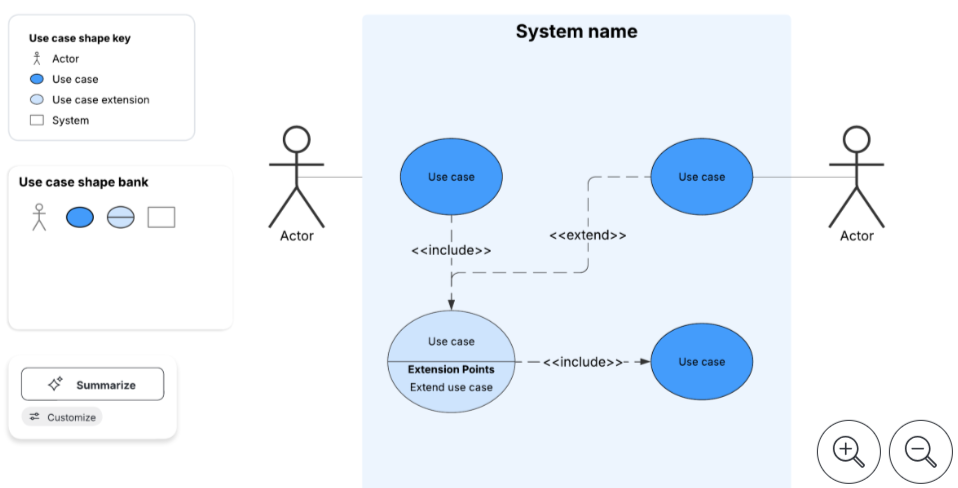Ever get the sense that something’s amiss in your business plan, but you can’t quite put your finger on what it is? You’ve got vision, talent, passion—but somehow, it just doesn’t quite add up the way you want it to.
That’s where use cases come in.
Use cases might not grab immediate attention, but they play a key role in aligning your team, uncovering opportunities, and streamlining your approach.
They’re more about what your system must actually do, not what it can do. Want to grow wiser, move faster, and finally connect the dots?
Keep reading to learn more.
What Is A Use Case?

A use case is a description of a particular process that explains how a specific individual interacts with a product, system, or business to achieve a defined goal.
For example, a fitness center can have one use case for new gym attendees to find guided workouts, while another is centered around personal trainers keeping track of client schedules and gains. Each scenario represents a unique interaction that helps the business tailor its services.
Use cases have grown to accommodate other platforms, with the most notable being digital. If the same store has an online document, a single use case could include placing a document order or helping beginners with tutorials or guides concerning skill renovation.
Upon identification, use cases enable business standpoints to be improved, both in person and online.
Moreover, use cases outline a definition of the system that should be put in place with actual user needs in mind, ensuring that development is aligned with company goals.
In this way, use cases manage users’ behavior as well as the design to help take your business goals toward optimal responses to the apparent customer needs.
Why A Use Case Is Important In Business?
A use case helps businesses design better solutions by focusing on how real users interact with a system—bringing clarity, improving communication, and aligning development with actual customer needs. Let’s see how use cases deliver value across different areas of a business.
- User-Centric Clarity
When you begin designing a system or business process, your mind will default to thinking about internal capability or technical function. However, to serve your customers better, you need to center your attention on them instead. That’s where use cases step in.
By specifying how your users will utilize your product or service in an attempt to accomplish specific goals, you can ensure that your design aligns with the ultimate user. Keeping such order supports group consistency regarding peripherally derived user requirements, rather than internally speculated ones.
Consequently, you develop features and solutions most directly addressing the problems of your most valuable people, your customers.
In addition, use cases keep you from losing yourself in abstract functionality. Because of these reasons, your product has a good chance of bringing about the desired effect and solving real issues.
- Improved Communication
Use cases provide everyone with a shared vocabulary in which all stakeholders—design, marketing, management, or IT—can discuss the purpose being constructed and why it is important.
Rather than being bogged down in technical terms or in-theory design, use cases offer a straightforward, narrative description of user intent and system response. This common vision reduces rework and miscommunication because everyone knows the overall picture and how their contribution fits into the result.
Additionally, a diagram can be employed alongside the written use case, adding even greater clarity across departments. Whether you’re in the early planning phase or halfway through development, having a well-defined use case ensures everyone is on the same page. That means fewer shocks, smoother collaboration, and faster progress.
- Comprehensive Requirement Capture
Capturing the right requirements at the start of a project can be daunting, but that’s exactly where use cases prove their value. Instead of just gathering surface-level needs, they prompt you to think deeply about both typical and less obvious user behaviors.
You’re not merely describing what will happen under perfect conditions, but also catching exceptions, errors, or side effects. This process surfaces hidden requirements — those tricky edge cases that often go unconsidered until it’s too late.
By systematically working through every conceivable interaction, you can develop a solid base for your product or system. You don’t leave gaps to be filled in afterwards, which eliminates the need for expensive revisions and scope creep.
Overall, with use cases, you can better define what your system is going to do across the entire spectrum of possibilities. Ultimately, that translates to fewer surprises during development and a more predictable, smoother user experience when it finally goes live.
- Facilitates Prioritization & Scoping
Once you have limited budgets and tight deadlines to work with, you want to prioritize. Use cases provide a structured approach to determining what matters.
Because each use case involves a specific user goal, it’s easy to determine which interactions are most critical and which are less critical. This defines project scope early and stops you from having extraneous features that won’t deliver significant value.
For instance, if you realize that most of your users depend on a specific feature to do some essential things, that’s where you focus. Conversely, if another interaction happens in such a way that it affects only a subset of users, then you can omit or postpone it.
Use cases make these trade-offs easier to justify to stakeholders, helping you stay focused on delivering what counts. As you work on your project, the structure also makes it easier for you to make corrections without losing essential goals. In short, use cases are beneficial for effective scope management and aligning stakeholder expectations.
- Supports Testing & Documentation
Once you’ve outlined your use cases, you’ve already done much of the groundwork for testing and documentation.
Each use case naturally breaks down into steps, decisions, and outcomes, all of which become the basis for test cases. This makes it easier for QA teams to validate whether the system performs as expected in real-world scenarios. And it’s not just about testing.
These same narratives help technical writers create user manuals or training guides that make sense to end users.
By tying documentation directly to user goals and system behavior, you ensure it stays practical and accessible.
Plus, when updates are needed, use cases serve as a reference point for what should change and why. They become living documents that guide your product not only during development but throughout its lifecycle.
So if your goal is to build a reliable, well-documented system that performs under pressure, use cases offer a strong foundation to build upon.
Conclusion
Now that you understand the power of use cases, it’s time to put them to work.
Use cases help you shift focus to your users, improve communication, and eliminate costly missteps. They ensure your product solves real problems and evolves with purpose. When everyone is aligned around user goals, success becomes far more achievable.
So, wait no more!
Let use cases guide your next big move—and watch everything start to click into place!
